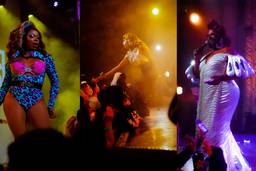Women of Vision: Histories in Feminist Film and Video
Edited by Alexandra Juhasz
University of Minnesota
Press 280 pages, $19.95
In the early and mid-’90s, feminist media art was everywhere: an explosion of video art dealing with identity, sexuality and feminist history. Much of it was made by women – with lesbians and women of color playing a particularly important role. The art world for a brief moment turned its attention toward the burgeoning movement, and works by young women like Cheryl Dunye and Sadie Benning appeared in the Whitney Biennial and other elite venues.
But as the millennium came and went, the art elites moved on to an interest in video more generally, particularly as it appears in installations. Ambiguity and purely formal concerns are now the priorities as the art world shies away from more socially engaged work – even though a lot of feminist art also has dealt with formal concerns. Alexandra Juhasz’s Women of Vision, a collection of interviews with 20 prominent female film and videomakers (and a complement to her 1998 documentary of the same name), is meant to prevent this important piece of cultural history from slipping away.
As Juhasz writes in her engrossing introduction, feminist film and video came out of the women’s movement of the ’70s, when the infrastructure of media access centers, collectives and venues created by activists enabled women (as well as poor people and people of color) to gain experience with technology they had never used before. For 30 years, feminist film and video has existed uncomfortably between art, activism and the entertainment industry. It encompasses everything from abstract, avant-garde film and documentaries to autobiographical work and community-activist videos.
Juhasz’s interviews bring out this diversity and the contradictions between her subjects. They range in age from their twenties to their fifties, across ethnicities and sexual orientations, as well as differing relationships to feminism. She notes that their only similarity is that they all do political work within contemporary culture, working with or concerning film, video, television and digital production.
The older generation of interviewees in Women of Vision–Carolee Schneemann, Barbara Hammer, Kate Horsfield and others – is much more strongly defined by feminism. Their concern with feminist issues seems hard-fought; many of them struggled with raising capital as well as for acceptance. Schneemann in particular is bitter that she has sold so few works, that she has never really had enough money to live on and produce the work she has envisioned. Hammer funded her own work out-of-pocket for a decade before she turned to more abstract filmmaking in order to attract grants (and it worked).
Some younger media artists, like Dunye and Eve Oishi, have a much more fluid, shifting sense of identity. For them, feminism is not always as central as race or sexuality. They are also critical of feminism for being anti-porn or too white. And while they have certainly struggled, funding and recognition seem to have come somewhat more easily to them than to their elders.
But what connects all of the women is a profound interest in speaking to an audience about complicated personal and social issues. Many of them are very concerned with reaching out to non-art and non-activist audiences to counter the damaging representations of women or people of color in the mainstream media, as well as to challenge them to think about identity in new ways. So Dunye made a feature film (1996’s The Watermelon Woman) not because she was trying to go mainstream, but because she believes that most African-Americans do not watch independent videos or attend gay and lesbian film festivals, and she wanted to make something they would see.
Despite the growing numbers of female visual artists, television producers and filmmakers, images of women in the media are still mostly limiting and embarrassing. Female visual artists wear designer clothing and mingle with the fashion crowd, while musicians and actresses are often distinguished by their lack of clothing. Carol Leigh, a feminist porn artist and former sex worker, tries to create positive images of women’s sexuality with her videos. She concludes, “We need more street-fighting women out there doing sex work and writing about it, making pieces. There aren’t enough images of big women, of fat women in the media.”
Meanwhile, Vanalyne Green thinks of video as an “Ellis Island” for women and poor people, and wishes that people would fight harder to legitimize the form. But feminist studies and film studies have become institutionalized in the academy. Juhasz claims that the most viable public places for feminism may now be women’s studies and queer studies programs at colleges and universities. This comes through most compellingly in interviews with younger media artists like Frances Negrón-Muntaner, Yvonne Welbon and Juhasz herself, who are very much positioned within the academy. But like Juhasz, one wonders what the effects of this inherently elite positioning may be.
Indeed, despite these filmmakers’ intentions, most feminist film and video is rarely seen by activist audiences. There is a long history of debate (mirroring debates within activism) about whether media should be more conventional in form to appeal to a broad audience, or more experimental to reject dominant forms of representation. Some films, notably Michelle Citron’s Daughter Rite and the work of people like Kathy High and Su Friedrich, have bridged this gap. Yet in this age of fast edits and the Internet, viewers are far more sophisticated and receptive to experimental film than they are generally given credit for. Perhaps the conflict between aesthetics and politics might not be as important as it used to be.
Juhasz says that Women of Vision is an attempt to resist the depiction of women who choose unusual and precarious paths in life as deviant and marginal. Instead, she hopes to examine “what it is to live the life of an artistic, intellectual, political woman in this society who finds herself compelled to speak to others, or speak from herself out into the world, onto a medium that records movement and sound in real time and that holds it there permanently.”
She certainly succeeds in this goal, as her subjects speak articulately and expressively about their lives, passions and careers. Women of Vision should serve as a challenge to activists and artists to ensure that feminist film and video does not fade into obscurity. It might also push the rising generation of video activists to explore more innovative and experimental forms, to take up feminist theory, and to think through matters of representation and subjectivity. Perhaps the next generations of feminist theory and media art will be found among them.







